As China dumps Treasury securities, the Euro Area, Canada, and financial centers load up with immense appetite.
By Wolf Richter for WOLF STREET.
The question that’s on everyone’s mind is how long foreign investors will continue to support the US Treasury debt that has now ballooned to $34.75 trillion and will nail $35 trillion over the next few months. These securities are all held by someone, and a portion of them are held by foreign entities.
So far, demand for these Treasury securities from all directions has been huge, as documented by the 10-year yield that should be above 5%, given where inflation is (3.4% core CPI with lots of uncertainty surrounding it), and where short-term yields are (5.5%). But the 10-year yield is just 4.2%.
The share of foreign holdings.
Foreign investors have continued to add to their holdings of Treasury securities over the years, but the US debt has grown far faster, and so the share of the debt that is held by foreign entities has been declining for many years. In 2014-2016, foreign investors held over 33% of the debt. Their share is now down to 22.9%.
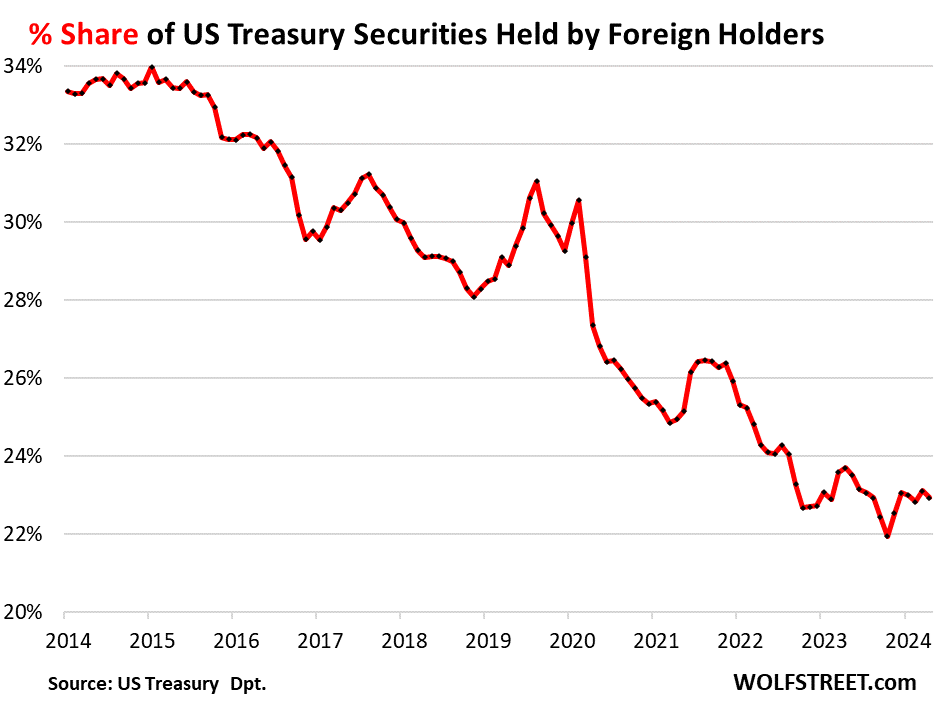
In other words, the US debt financing has become far less dependent on foreign holders – and as we’ll see in a moment, even less dependent on China and Japan.
In dollar terms, Treasury debt held by foreign entities rose to an all-time high in March, and in April dipped a tad, to $8.02 trillion, which was up by $468 billion year-over-year, or by 6.3%, according to Treasury Department data on Tuesday (red line in the chart below).
- Top six financial centers (London, Belgium, Luxembourg, Switzerland, Cayman Islands, Ireland): $2.3 trillion (blue), +9.2% year-over-year, despite a dip in April from the all-time high in March.
- Japan, #1 US creditor: $1.15 trillion (green), +2.2% from a year ago. Over the past 12 years, Japan’s holdings have remained in the same range between $1.0 trillion and $1.3 trillion, hitting the low end of the range in 2011 and 2018.
- China and Hong Kong combined: -9.1% year-over-year, to $992 billion (purple), up a tad in April from the lowest in many years.
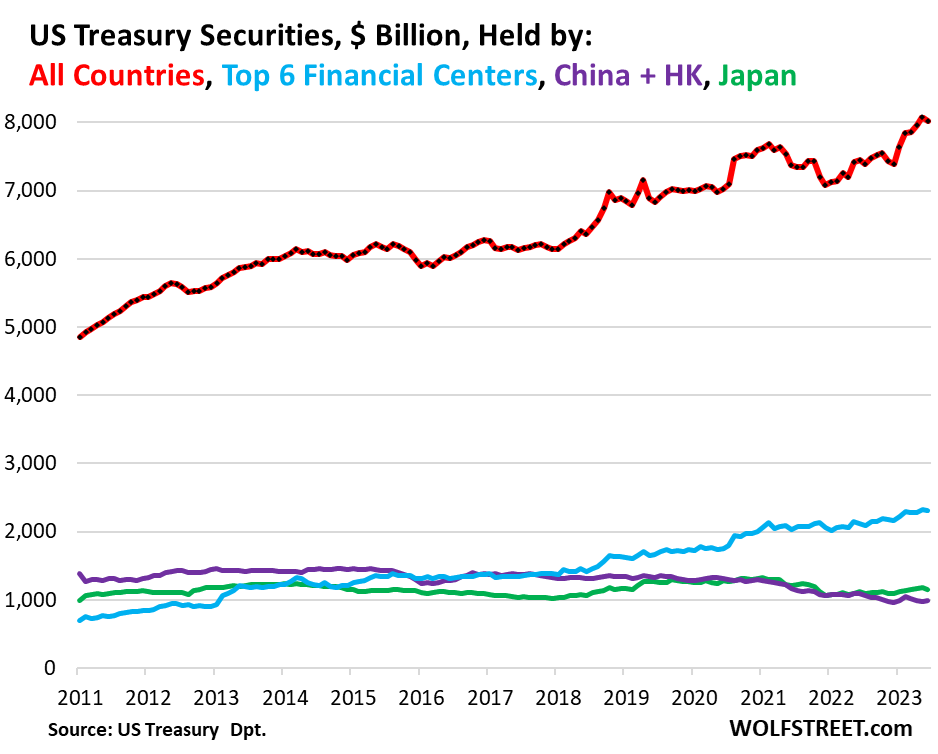
China + Hong Kong v. the Euro Area.
China and Hong Kong whittled down their combined holdings from over $1.4 trillion in 2012-2017 to $992 billion now (blue). During the capital-flight panic in 2016, China’s holdings of Treasury securities fell sharply as it tried to prop up the RMB. It increased its holdings again, but never all the way back to the prior level, and holdings have declined from then on.
The countries of the Euro Area piled into US Treasury securities at a furious rate, expanding their holdings from $500 billion in 2011 to $1.58 trillion now (red), and increase of over $1 trillion. Year-over-year, the Euro Area’s holdings surged by $202 billion, or by 14.6%!
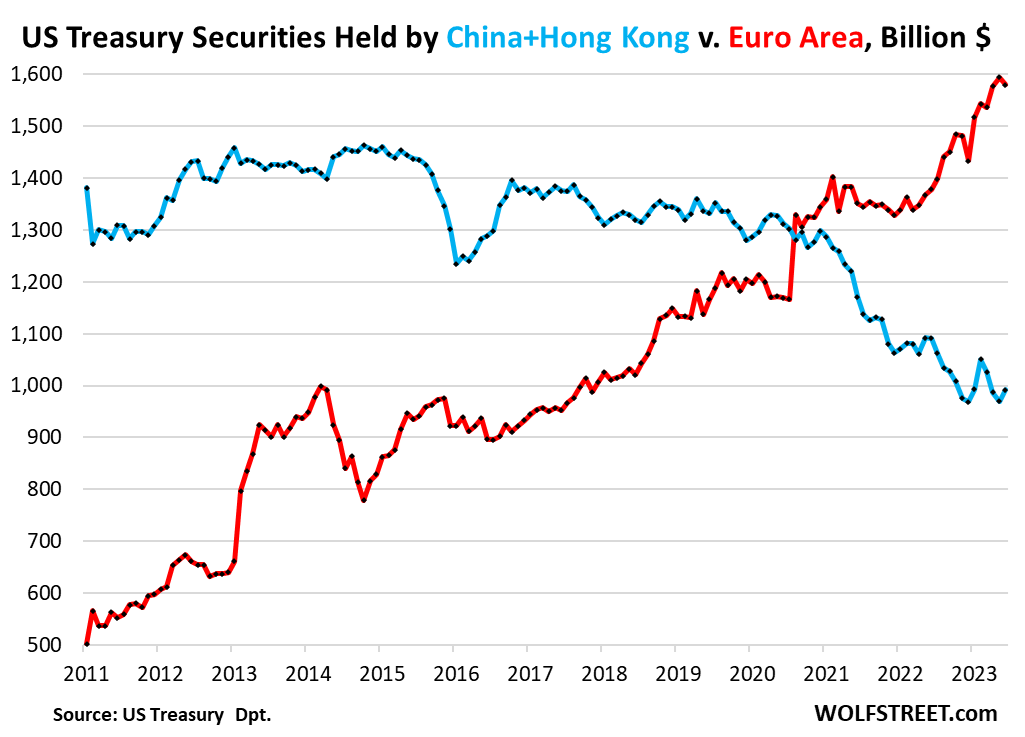
The six largest financial centers – the UK (the City of London), Belgium, Luxembourg, Switzerland, Cayman Islands, and Ireland: +9.2% year-over-year to $2.31 trillion, the second-highest level ever, just behind March, having more than tripled since 2011!
These countries specialize in handling the financial holdings of global companies, individuals, and governments. Ireland is a favorite for US companies to store their profits. So some of their holdings are actually held for US entities.
- UK: $710 billion
- Luxembourg: $384 billion
- Cayman Islands: $319 billion
- Ireland: $308 billion
- Belgium (home of Euroclear): $312 billion
- Switzerland: $272 billion.
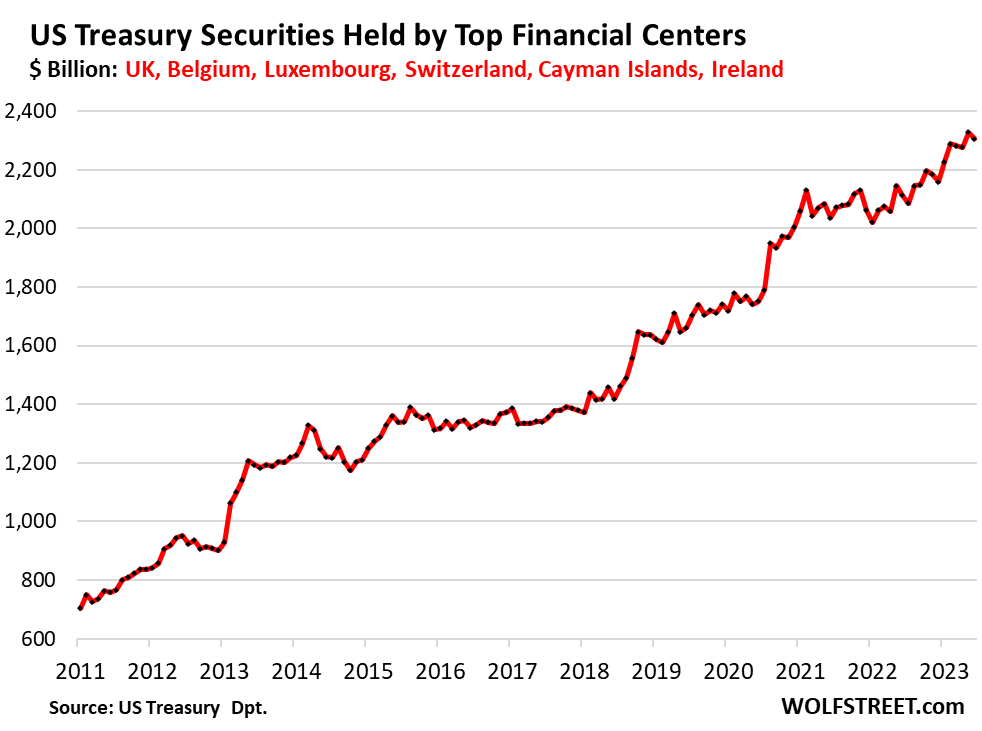
Japan’s holdings: +2.2% year-over-year, to $1.15 trillion, with a drop in April. They zigzagged higher, starting in late 2022, after dropping sharply.
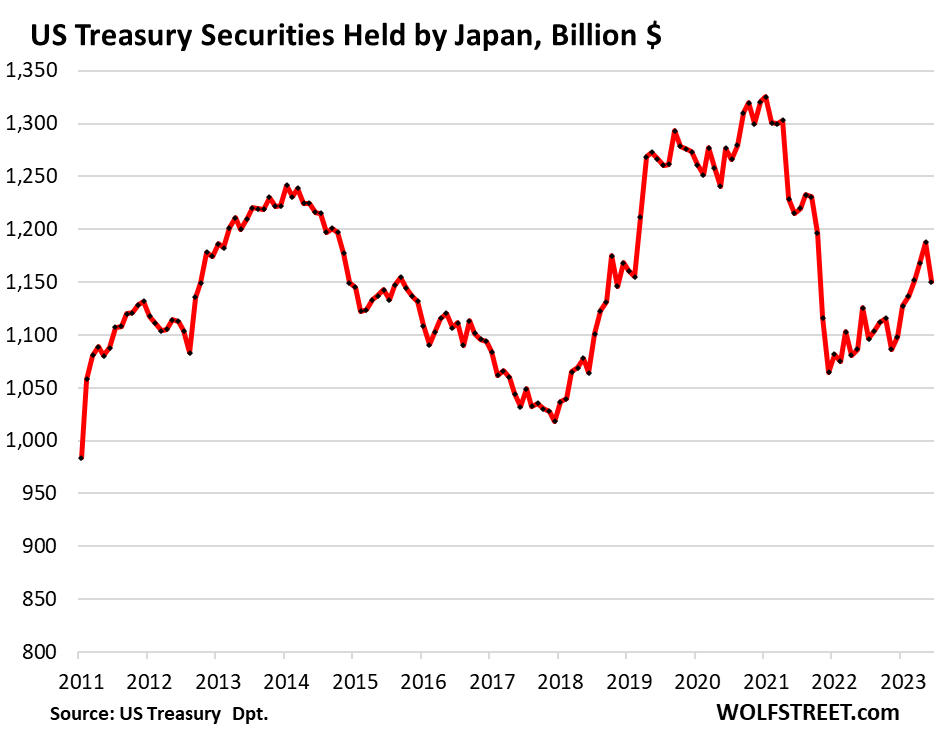
Other top foreign holders of Treasury securities:
Canada’s holdings: $338 billion, +36.9% year-over-year, despite the drop in April! Holdings have multiplied by 7 over the past 12 years! Canadians love US Treasury securities so much?
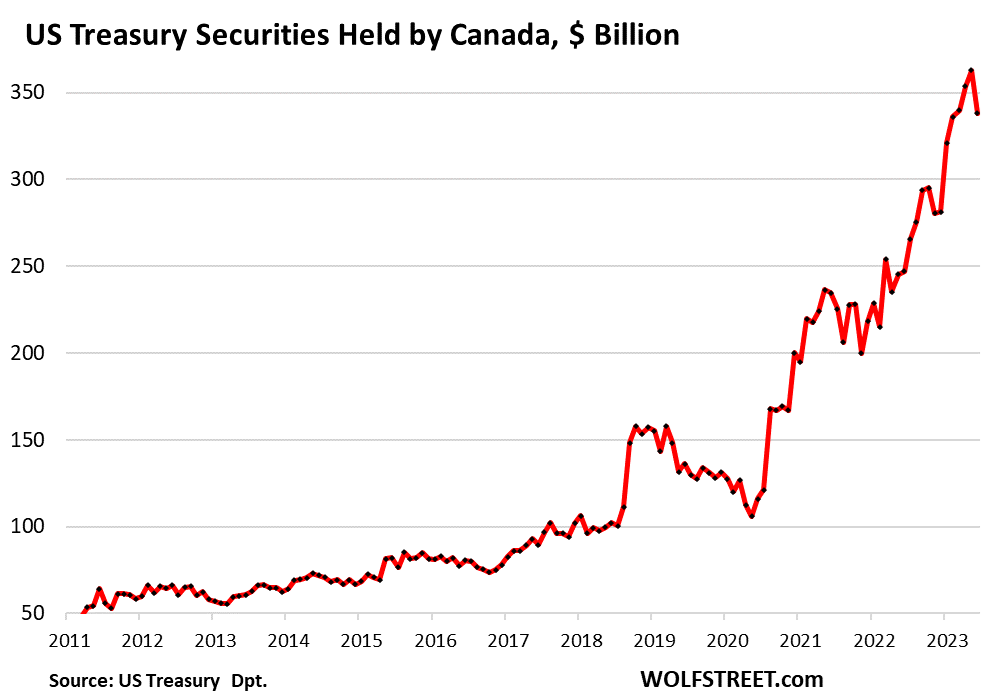
Taiwan’s holdings: $257 billion, +5.3% year-over-year, a tad below the record high in March:
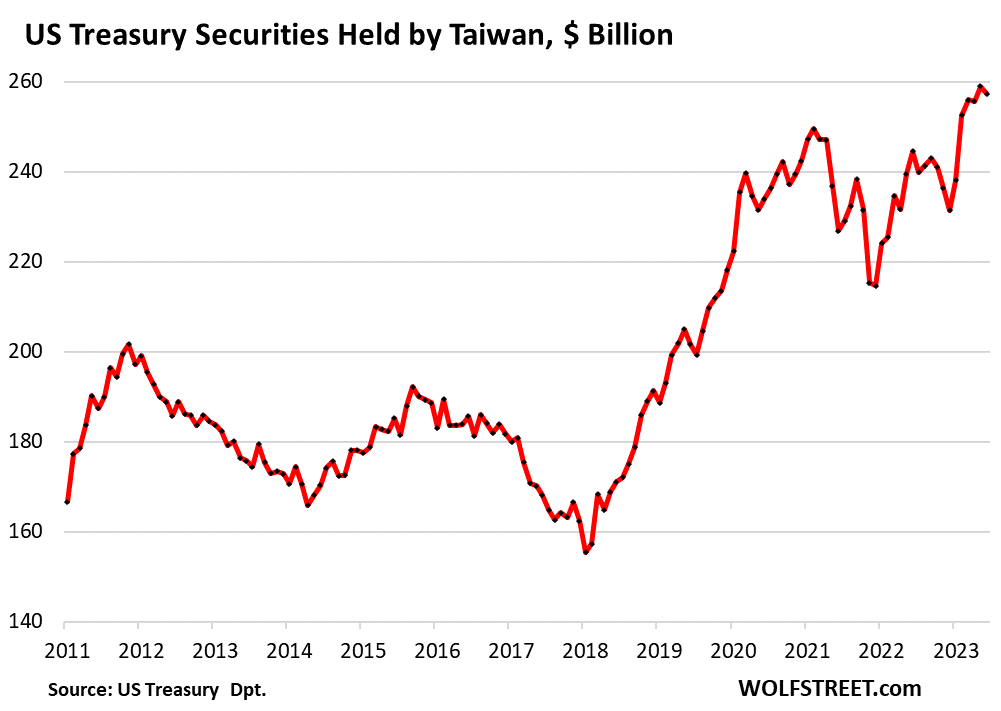
India’s holdings: $234 billion, -2.2% year-over-year. India has multiplied by six its holdings since 2011:
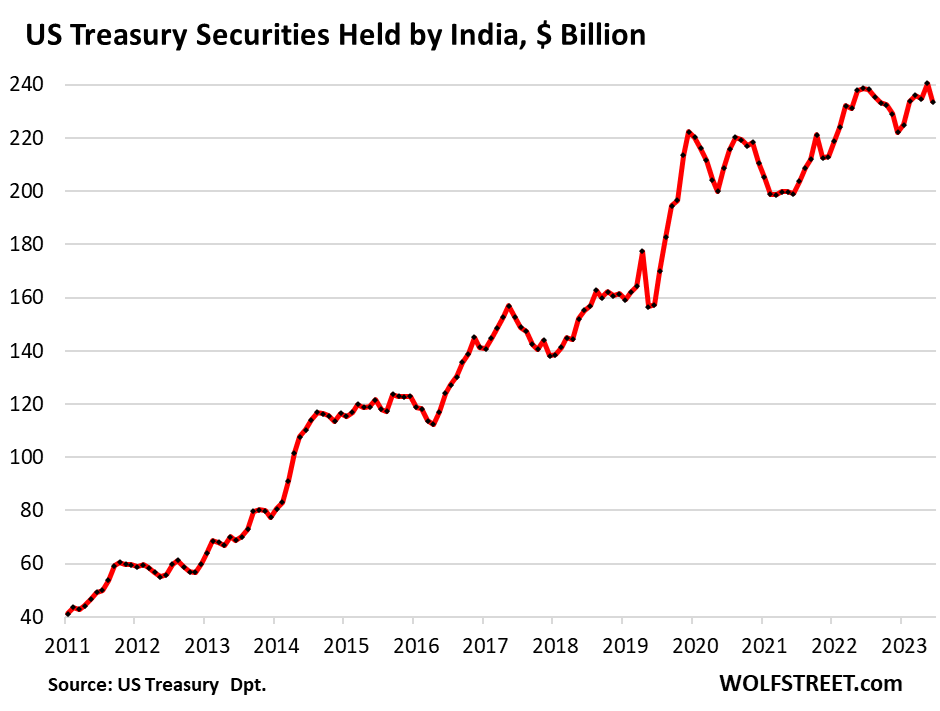
Brazil’s holdings: $224 billion, -2.7% year-over-year. In 2023 and 2024, the trend has been higher, after having spiraled down by about one-third since the peak in 2018.
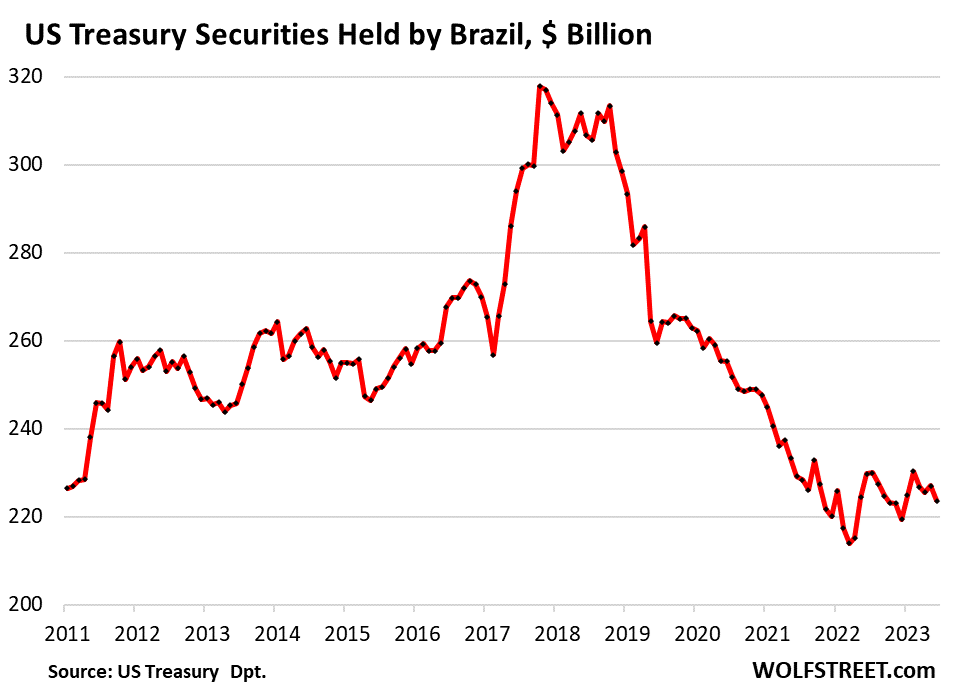
France’s holdings are part of the Euro Area chart above, but it’s one of the biggest players in the Euro Area, along with the financial centers in the Euro Area, and far bigger than Germany. And its holdings have shot higher and in April reached a new all-time high of $277 billion (compared to Germany which holds just $87 billion):
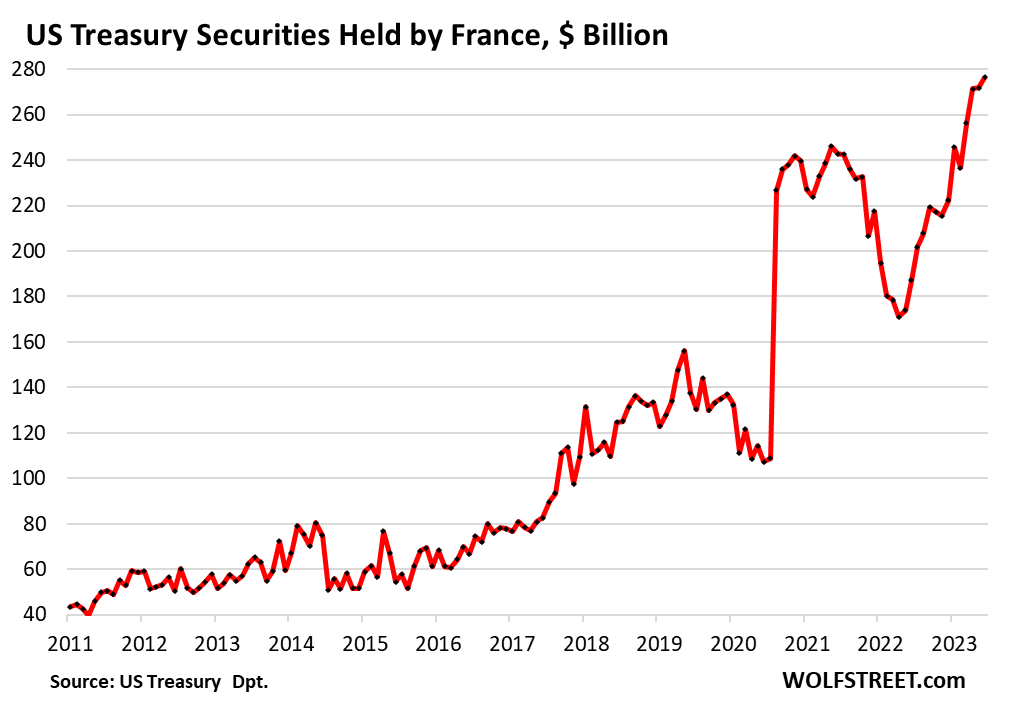
Enjoy reading WOLF STREET and want to support it? You can donate. I appreciate it immensely. Click on the mug to find out how:
![]()


Howdy Folks. Bubba says always save some of your hard earned money always, always, always and buy 28 day T Bills. That way, as you watch the show, YOU decide when it is best to fold, hold , bet the pot………..
Are you advising to do the same with your mortgage?
Howdy SCBDude. Mortgages should be paid off ASAP. My last one was in my 30 s. Then HELOC or business loans to gain wealth. Always save $$$$ for rainy days…..When you have lots of nuts saved, does not matter what Govern ment or anyone else does to you.
so we are looking at doing mortgage with 15 year
5% because we put down 40%
discount for paying off in 1st year(15%)
2nd year (10%)
and of course assumable
sellers don’t want to discount
so I’m doing it on backside
they don’t believe I can payoff in 1 year
I can, but may choose to sell instead and let them carry mortgage
No thanks. As long as those bozos in Washington want to keep recklessly spending money, I’m not giving them any more than I’m forced to.
Howdy Brandon. Just look at the debt clock and past history. Limited Govern ment is fiction. You can not hide from Govern ment and they will always take what they want. Debt Free allows you freedom.
@Debt-Free-Bubba,
“Debt Free allows you freedom.”
+1
Bubba, I agree.
Only hold debt that charges less than 28 day TBill rates, like a mortgage at less than 3%. Never pay the mortgage off while Tbills are paying 5.5% and you are paying less than 3%.
That is the key to safe freedom. Until Tbill rates change to below 3% again, then nevermind….
Howdy BobE. If you have to have debt, YEP, silly to give up the 3 %.
Took me till my 30s to become debt free. Always borrowed for business but once my personal debt was 0 ???? No going back for me. Would drive my wife crazy when I would rehab and resell properties that were better and bigger than the one I lived in. HEE HEE
60 days from now, my mortgage is paid off. Folks talk about rising maintenance and insurance costs, but I have the luxury (and patiently accumulated liquid reserves) to shrug it off. What a beautiful feeling. It’s 4:16 a.m., I’m going for a 3-hour walk-run (and I’m an old guy), going to cash in also on the health benefits of it all.
Howdy NON Debt Slaves….. YEP, being a Debt Slave is the worst.
Duh. As Wolf’s article suggests the long term treasuries are under priced and the rational money won’t touch em.
Howdy Dang. Thats the beauty of CASH. Short term and easily accessible to do what you want, when you want…..
US federal Debt on Pace to Top $56 Trillion Over Next 10 Years!
Wolf, so I saw this item yesterday,
What does this mean for the Treasury market in general (if anything), and how does it fit into the article’s overall premise
Well, it doesn’t like to copy and paste it seems, so…
Japan’s Norinchukin Bank plans to sell 63 Billion in US and European gov’t bonds. by Mar 2025 to “stem its losses from bets on low-yield foreign bonds….
What does this mean for the Treasury market in general (if anything), and how does it fit into the article’s overall premise
What they said is that they’re going to take their time selling these assets — about a year — and so that’s about $5 billion a month of a fairly broad range of assets in several currencies. I think this is too small to have a visible impact on the Treasury market.
Wolf, do you see the potential of their decision as a precursor for other big Japan banks to see the writing on the wall and start front-running Norinchukin decision? I would guess their are several other banks in the same boat and they may want to take this opportunity to also lower their holdings?
Well…
For every seller there has to be a buyer and if there are no rational, economics driven buyers, there is only the US Federal Reserve (Money Printer/Inflation Creator in General)…
That’s why all the US Treasury foreign holder charts are somewhat less important than they were historically (although they likely still matter a fair amount for international trade flows).
Basically, it looks like the US government has simply given up fiscally – it hasn’t been able to generate a balanced federal budget for basically over 50 years and its deficits have only grown worse. Long-standing recent evidence indicates that DC isn’t even trying to remotely balance its budgets any more.
The G’s tax revenue funding mechanism has been inadequate to satiate the insatiable maw of DC’s spending side…so there is nothing incrementally left other than money printing.
Other governments see this (“You are a bad little pony and I’m not betting on you anymore” – House of Games, heh) and their long term appetite for fiat scrip (which they themselves traffic in) is therefore very limited (except, perhaps, for trying to squeeze out/prop up the dregs of international trade flows).
The future story therefore is going to be more and more about the US G self-funding via the Fed (lender of last resort, money printer/inflation source of first/only resort).
The only question is how quickly/profoundly/powerfully the US public is going to tie their soaring consumer/housing prices to the pathological spending/taxing habits of DC.
“if there are no rational, economics driven buyers”
The latest Treasury auctions have seen stellar demand.
MM,
Seeing some demand at semi-normalized rates (5%+…although honest, inflation/risk adjusted rates would be wayyyy higher) is one thing.
But let’s see how many non-state-actor (and US state actor at that) buyers there are at ZIRP era rates of 0%-2%.
That’s the whole reason why “quantitative easing” (read “money printing” in honest, non-DC terms) had to be invoked – in order to drive down soaring rates in the wake of Implosion 2008 (first in a series…).
No non-state actors (with a money printer/inflation machine behind them) wanted to get within a million miles of ZIRP era rates…again, the *whole reason* Fed “quantitative easing” had to be invoked.
But, in a bad parody of “Pulp Fiction”, DC has become addicted to living a fiscal lifestyle that inevitably leads to having that giant needle of adrenaline slammed into its heart to “save” itself.
Call it “Pulp Paper Fiction”
cas127,
Personally, I am surprised treasury demand has remained so robust, and yields so low. I had been predicting that increased auction sizes would see weaker demand, but so far that hasn’t really materialized.
That said, how much of that demamd do you think is coming from rate cut speculators hoping to make a quick buck flipping bonds, vs long-term holders that are content to earn 4.2% for the next 10 years?
You can almost argue that the 10 year tsy being >100bps lower in yield than the 13 week bill (!) is a sign of *too much demand* for treasuries.
This truly is an everything bubble: stocks, RE, crypto… we’re even bidding up US gov’t debt.
I wonder how all those bag holders are feeling that were buying hand over fist in 2019, 2020, 2021?
Norinchukin is just the tip of the iceberg
I think bond prices are going to increase as the bellweather Vanguard Total Bond Market Fund likely bottomed recently around $68 and its all upside from here for that fund until the next inflationary cycle.
So should the bagholders of 2020 and 2021 just wait longer as bond prices recover more ?
If I bought Vanguard Total Bond Market Fund in July 2020 then I bought it at its all time high of around $90. Now it is about $73.
I’m conservative (at age 54) with my IRAs which is essentially 50% stocks (total stock market fund) / 50% investment grade bonds, and took a sizeable hit with bond prices falling like a rock from July 2020 to 2023 because of annual inflation increasing from less than 2% to +8%.
AD,
If you think bond prices will go up, then rates by extension go down. Do you really think rates (duration) have much downside with the risk free rate (5.3%) over 100bps higher?
I’d urge you to reconsider your thesis – you don’t want to be stuck underperforming the risk free rate of return. Think about a scenario like the stock market correcting and then trading sideways for the next decade as rates and inflation remain high, and then think about how you can sit in treasuries earning 5.3% with zero risk.
NB: for entertainment only, not investment advice
Hello MM,
I understand the economic natural tradeoff as far as price going up and yield consequently going down.
I’m in the long haul as far as 50% of my IRA essentially in the total bond market fund (ticker: VTINX).
I’d be content if the fund’s yield at least is equal to the annual inflation rate.
But yes I was looking at the yield curve, and see reason to short term fixed assets, even 1 month CD’s earning 5%.
I unsurprisingly noticed the 30 day yield for VTINX is 4.63%.
I’m not sure if Personal Consumption Expenditures average above 3.25% annually for the next cycle (i.e., next 6 to 10 years).
VTINX yield is 3.10. The yield of VTBIX which is 37.3% of VTINX is 4.62.
You don’t lose anything if you hold to maturity. Just don’t be over extended like these zombie banks, that are forced to sell when under water.
That is true as long as you don’t hold bond funds. You have no control over when the fund managers sells. You’ll take the loss immediately when interest rates rise. Own individual bonds. Easy to do.
Or just hold short term and ultrashort term bond funds.
BobE, there’s technically still counterparty risk from the fund itself, fyi.
Ultra short bills (13 week) are easy to continuously roll over, and if you buy them thru your broker you can sell them for cash whenever.
At worse, hold intermediate bond funds like VTINX.
Vanguard does a good job with bond laddering.
I agree as far as just holding to maturity and earn the interest.
I like a lot the I-series savings bonds.
And the danger/reality is that *any* sizeable holder of the underwater ZIRP-era fixed income crapola can trigger a “dump-run” by announcing/acting to initiate a sell-off of the crapola.
At that point, why would all the other bag-holding imbeciles of the ZIRP-era not try to move first/quickly to dump *their* crapola for 95 cents on the dollar before it goes to 85 cents (then 75, 65, 55,…).
“These securities are all held by someone…” Jerome Powell said the Federal Reserve is going to concentrate on having Treasuries for their portfolio. The Federal Reserve can just buy up any amount that doesn’t sell to investors.
In theory, sure. But the Fed is now doing the opposite, via QT, shedding Treasuries. It already shed $1.3 trillion since June 2022, and holdings are down to $4.46 trillion, the lowest since September 2020. The Fed has now shed 40% of the $3.27 trillion in Treasury securities that it had added during pandemic QE.
https://wolfstreet.com/2024/06/06/fed-balance-sheet-qt-107-billion-in-may-1-71-trillion-from-peak-to-7-26-trillion-lowest-since-december-2020/
shed by maturity roll off, so not selling. and if more matures than the monthly target then excess above is reinvested in new debt. so with such a huge portfolio of bonds, even in so-called qt-mode, the fed is still a huge buyer of new treasury debt.
No, on net the Fed became the largest dumper of Treasuries ever. If $65 billion mature in a month, and come off the balance sheet, and the Fed buys $5 billion back, it has effectively dumped $60 billion on the market that someone else had to buy because the government replaces the maturing debt with new debt (roll-overs), and someone else else to buy that new debt, not the Fed.
That happened in a few months, but in many months, the roll-off was BELOW the cap, and the Fed used its T-bill maturities to make up the difference.
So with QT, the Fed is dumping Treasuries and since a lot were bought near zero interest rates were , they are taking a loss after they raised interest rates to around 5% and are not thus sending any profit to the US Treasury now like they normally do, until they make future profits and eliminate those losses on paper after which excess then resumes to the US Treasury (my shakey understanding of the process Wolf)
So what I found alarming was your graph showing Canadian debt purchases which skyrocketed up since about 2018 till 2024 whereas overall other foreign US debt holdings have been in steep decline, likely initiated by US sanction/Swift denial policys against Iran, N Korea, China and Russia where both the US and Canada ended up confiscating Russian financial assets to help fund Ukraines war effort weaponized the dollars as reserve fiat currencies leading them to wonder if it could happen to them, maybe we ought to start buying gold instead of US debt.
Getting back to Canadas huge appetite for US debt, most of which being bought 2018-2023 before inflation peaked and Powell jacked up short term rates to current levels, my own guess much of the Canadian US debt is now underwater and its holders are now sitting on huge, yet unrealized capital losses.
It makes me wonder how safe the Canadian banks and government’s are now. Could what happened to 3 American banks failing, also happen in Canada as well? Appreciate your take on a) my understanding above and b) why Canadian US debt holdings skyrocketted before Powell jacked uo rates to control inflation. I fail to see the attraction of a bond paying close to a zero coupon.
1. “So with QT, the Fed is dumping Treasuries and since a lot were bought near zero interest rates were , they are taking a loss after they raised interest rates to around 5%..”
That’s wrong. The Fed doesn’t “dump” (sell) Treasuries. Between $30 billion and $90 billion in Treasuries in its portfolio mature every month, month after month, and the Fed gets paid FACE VALUE for them when they mature. Under QT, the Fed simply does not replace the maturing securities with new securities. It just lets them “roll off” (mature without replacement), and its portfolio shrinks every month, and it gets paid face value. There are no losses involved.
The operating losses that the Fed does have relate to the interest income from its shrinking low-yielding portfolio not being enough to pay for the interest it pays on reserves (5.4%) and reverse repos (5.3%). This article explains that:
https://wolfstreet.com/2024/01/12/fed-reports-operating-loss-of-114-billion-for-2023-as-interest-expense-blows-out/
2. “whereas overall other foreign US debt holdings have been in steep decline,”
This is totally wrong. You didn’t actually look at the charts. Look at the top two charts again. The dollar holdings have been rising from record to record (Chart #2); but the SHARE of foreign holdings as % of total holdings (Chart #1) is down because the overall debt has surged so much, and foreigners have increased their holdings but not as fast as the debt increased.
This is where I stopped reading. Your premises are just wrong.
So, the point is that the US is still the mighty juggernaut of world finance. The Fed bankers always seem to keep the ball rolling in their direction. US citizens ENJOY.
Enjoy the times while they’re good and while you can. And set a little aside in case tomorrow’s a rainy day.
There are only two times a person can make real money.
One is good times; the other is bad times :)
As is the blessing/curse ”May you live in interesting times.”
eh L?
Yes, enjoy now because I believe our days are numbered.
OF course our days are numbered DR:
For many decades, I have said to others, mainly to remind myself, ”don’t take life too seriously: no matter what you do, you’re NOT going to get out of it alive.”
As to the ”real” number, that is absolutely fixed, until and unless you can totally grasp and proceed accordingly, that all the past, including genetics, nurture, etc., etc., are NOT your fate, but your challenges.
YOU get to decide, daily, hourly, every time there is a choice, and as one of my honorable mentors once said, ”One always has a choice, even at the point of a gun.”
Have a nice day!
”One always has a choice, even at the point of a gun.”
That’s the honorable take.
But the nihilists who have controlled the US government/society for decades only listened to the lesson at the start of “The Departed”
“When you decide to be something, you can be it. That’s what they don’t tell you in the church. When I was your age they would say we can become cops, or criminals. Today, what I’m saying to you is this: when you’re facing a loaded gun, what’s the difference?”
A couple of generations of American Costello’s took us from nonpareil superpower to debt-ridden wreck in 50 years.
And they are still retailing the same old crapola through the same old MSM sluice channels.
I see US treasuries in the same way as Las Vegas chips(tokens whichever) not something you would buy a lot of personally, but if you want to play the game, speculate/gamble, then you have to have them. And there is a lot of finance industry out there.
Other than that, like an ice floe, that might float for 10 years before tipping over entirely in 2 minutes.
It’s very hard for me to separate my economic doom love from any proper analysis, but truly, with the Japanese looking like panic selling, and the issues in Europe, its hard to see a rosy future for US treasuries. No country has ever wanted to hold them, its just a consequence of petro-dollar, mercantilism by China and actually Japan as well. Or bureaucrats with no skin in the game as reserves, or forced purchasers pension schemes, insurers, banks.
I like the US and go there on holidays and have American friends (entirely Republican they predominate abroad) but in the end the debt goes too far as demonstrated by the Romans, Portugese, Spanish and British moments in the sun.
“I see US treasuries in the same way as Las Vegas chips”
I guess if you’re talking about duration, sure.
But T-bills are equivalent to cash, i.e. they are risk-free.
“its hard to see a rosy future for US treasuries.”
How about this picture: Treasuries pay a higher yield and have less risk than any other countries’ bonds.
Those countries were kingdoms, ours is simply a business. The moment in the sun will end when there is a bigger business elsewhere, which seems challenging given global demographics. The gdp of California alone would rank as the fifth or sixth largest country in the world.
The asset price bubbles are in danger of deflating in their own manner. The treasury market is a dramatic example of human behaviour. Confused and erratic.
The treasury issuance hasn’t been this unreliable since before the first world war and 20 years later, the second world war.
i can’t tell if these charts show total face value of bond holdings or if older bonds are discounted to reflect the increase in rates since many were issued. e.g. did china’s holdings change at all or are its bonds just being marked down because rates went up? i think this information is required, preferably decomposed into a rate change discount and a face value change.
Face value. Central bank holdings are always at face value, including the Fed’s holdings. In my TreasuryDirect account, Treasuries are also listed at face value, and that’s OK since I cannot trade them in that account. I hold to maturity and get face value, end of story. But in my brokerage account, securities are listed at market value, though I also hold them to maturity and then get face value. So if you don’t want to trade the bonds, but hold them to maturity, and if you don’t use them as collateral, the constantly changing market value is just a meaningless figure since it doesn’t apply to you.
I love the clarity of your explanations- you should be teaching finance or economis.
In my treasury direct account I get face value PLUS interest.
🤣 me too.
I even get interest in my brokerage account, can you imagine?
Good thing other central banks are starting to cut, but the Fed is not. Why would you invest in your own country’s debt when Uncle Sam pays you a higher yield, has cleaner sheets, *and* will loan you dollars?
Fed haters won’t admit it, but they’ve done an excellent job at defending the dollar and demand for Treasuries. The latter is still globally recognized as the most pristine, risk-free collateral to lend against.
Think how strong the dollar would be if the Fed had actually done its job the last 16 years, our standard of living world have been much higher, retired people would have billions more on their bond and CD investments, and there would have been a much smaller inflation bump post pandemic (Fed fiddled for a full year with their “transitory” BS).
Well, the strong dollar is the capitalist demon that gutted the United States manufacturing base. It was way cheaper too manufacture products in China, under contract with the CCP, the Communist Chinese Party, in direct competition with American labor.
That’s not the strong dollar’s fault. That’s the fault of American capitalists (Walmart!) that are always searching for the cheapest labor. If they cannot get slave labor, they’ll go to distant places with very cheap labor, if the government lets or encourages them. Big tariffs — a tax on profit margins — were needed to curtail this, but globalization became a religion that had to be believed in.
Precisely this, Wolf. And now we’re getting the hangover after that giant globalization party.
…thank you, Wolf!
may we all find a better day.
I agree with you on this but you are missing the bigger point..
Usd has lost its 65 percent of purchasing power in last 5 years and this hits quality of life for Americans right away in a tangible way.
Young people and renters have been locked out of housing markets for years to come.
“Usd has lost its 65 percent of purchasing power in last 5 years…”
Is that a typo or are you really suggesting it now takes $3 on average to purchase what $1 purchased 5 years ago? The inflation is/was bad, but that’s not even close to accurate. For example, if prices on average doubled over five years, meaning 100% inflation for the period or a little over 14% per year, then the purchasing power of the dollar would only decline by 50% during the period. No need to overstate the decline in the purchasing power of the dollar. Reality is bad enough.
“Usd has lost its 65 percent of purchasing power in last 5 years… Is that a typo…”
It’s not a typo. He has been saying this BS for over a year, and I have been deleting this BS for over a year, but just missed this one. Apologies.
“Usd has lost its 65 percent of purchasing power in last 5 years…”
Percentages are hard.
Repeating stuff that is obviously false over and over does not make it true. It just makes you look foolish for constantly repeating something that is obviously false.
Why do you you insist on looking foolish to everyone?
Agreed that the 65% loss of purchasing power claim is nonsense. HOWEVER, please note that the Truflation website is very highly regarded for its incredibly detailed quantitative analysis of inflation, which is an incredibly complicated beast and very hard to analyze with one index. That being said, Truflation states that the U.S. dollar has lost 25% of its purchasing power since Jan 2020. That is a stunning figure, and explains why people are very stressed about inflation, despite supposedly recent “good news” on the inflation front. When deflation recovers that lost 25%, then maybe people will feel better, but don’t hold your breath. In fact, I would not be surprised to see the Inflation Beast rearing its ugly head again in the next few years. These are troubled times…
The Longer View,
Truflation is a bullshit measure. It’s NOT “highly regarded,” but dismissed by anyone who knows anything about inflation tracking. For example, it uses “asking rents” as an inflation measure for rents. That’s total ignorant bullshit. NO ONE pays asking rents, that’s what landlords want on their VACANT units. Tenants pay ACTUAL rents, and those actual rents are tracked by CPI.
in some respects yes, and in some respects no. the fed should have done more to dampen speculation. think about it. people falling all over themselves to pay idiotic prices for shares of nvidia is basically saying that they would rather have those than the equivalent amount of dollars.
that isn’t a testament to the united states dollar being protected.
What are you talking about. Speculation is the point.
Believing that the Federal Reserve policy is hawkish has been wrong for the past 50 years. The Fed will do whatever it has to to prevent the stock market from collapsing.
The Fed let the stock market collapse just fine in 2000-2003 (Nasdaq -78%) and then again in 2007-2009 (S&P 500 -50%).
I do not want to see “reduce speculation” added to the FED’s charter. That would be a disaster. Besides, who decides what is speculation?
The FED should purely be focused on inflation, it is bad enough that they also need to focus on employment. Fortunately that is closely tied enough to inflation that it is tolerable.
Furthermore, how do they stop speculation? It would require them to throw the economy into a huge recession, which violates their employment mandate.
JimL – the longstanding (and fluid) question of what might be better-considered ‘public utilities’ (gasoline, grocery and housing pricing discussions here come to mind) vs. what is best dealt with by an always-speculative marketplace (or that seemingly-difficult to achieve ‘well-regulated’ one envisioned br Adam Smith…).
may we all find a better day.
For the record, I fully disagree with the last 15 years of ZIRP and QE.
But what’s done is done, and right now it’s fascinating to observe how the Fed is maneuvering on the global stage.
TINA only. I highly doubt anyone still believes it is the most “pristine, risk-free” collateral. It’s the lesser of the evils only. 35 trillion in debt shows how well we manage our money lol. I’m talking mainly about the morons in congress.
That comment was supposed to be a reply to MM.
“I highly doubt anyone still believes it is the most “pristine, risk-free” collateral.”
Seriously?
Yep, seriously.
For the record I 110% agree with your morons in congress comment LOL
But consider that basically anyone will loan you dollars against a stash of treasures – this DESPITE the reckless, spendthrift habits of Washington DC.
The Fed is being the adult in the room right now IMO.
Certainly it would depend on what type of US debt you’re talking about. Bills 6 months or less are one thing. Who in their right mind bought a 30 year bond at less that 1% and considered it “safe” because they will get their initial investment back in 30 years!
“Who in their right mind”
As Wolf would say, ZIRP turned investors’ brains into mush.
I think if history were different and rates went negative as some predicted (Not Wolf), 1% would seem pretty good as a safe investment.
Inflation got in the way.
Wolf’s analysis has been the only sanity for the last 4 years.
The 30 year is at 4.6 + pct which I think is still a bad deal. Especially when one considers the financial leverage that long term bonds carry
Pretty much all duration is a bad deal right now.
Extremely useful graphs. Politicians like to treat China as the main bondholder, which is no longer true.
The ups and downs correlate pretty well with the growth of the BRICS side and the shrinkage of the Five Eyes side. India is the only exception, but India is an exception to all rules. Since 1947 India has been the only consistently neutral power, the only major country that stands back and plays with both sides to serve its own interests.
A bohemian belief in a cause which you obviously lost.
I read foreigners buying US stock equities is at a record high. The US leads the world in AI and a lot of foreign money that does not want to miss out on AI is sending up the stock market. IMHO.
According to last thing I read is they now hold over 12 trillion in US stock.
Well if you’re financing an enormous capital account deficit (and the USA certainly is) – you need to finance that with asset sales of some type.
The upshot here is that if higher interest rates slow earnings growth in the tech sector – foreign appetite for stocks will likely decline and the USA will need to sell some other type of asset to fill that void.
which is bad, because history shows that foreigners start buying when stocks are already very expensive and then they start panic dumping them the moment a drop starts.
it means that an otherwise orderly decline becomes rapid.
Although I’m always uncomfortable in going over my head in matters I have no clue about, my initial gut reaction to this foreign buyers conundrum , was to be curious about what foreign buyers as an alternative — or if foreign buyers are simply unable to spend as much.
That forced me down the rabbit holes of currency and bond differentials, a place that’s far above my pay grade.
However, there’s obviously some interplay here with global trade balances and the interplay with inflation, and treasury rates — super simple dynamics….
The following petroglyph on a wall seemed to offer a possible clue as to why foreign buyer demand is weaker:
“ International trading which involves two currencies has a self-correcting mechanism.”
Apparently, their weakness relates to our strength, but, I await further clarity…
This trends are actual evidence of a birth of a multipolar world. As Dali painted the birth of a new Geopolitical child, that’s what we are witnessing today.
Europe (the West) piles into U.S, and the rest of the World gets out of it. China’s selling of tresuries is a clear statement, as the Chinese don’t do anything without thinking.
I’m pretty sure that China is just a canary in a coal mine, the countries of Global South and BRICS will not buy U.S. debt anymore.
The stolen Russian funds, oh, excuse me, the “frozen assets”, were a clear message, where this is going.
Certainly appears to be dependent, sometimes heavily dependent, on the ”party” or ”side of the aisle” in power in the BRICs, etc., and possibly equally the side, etc., in power in USA.
Certainly appears to be ”interesting times” these days, eh?
“Europe (the West) piles into U.S, and the rest of the World gets out of it. China’s selling of treasuries is a clear statement, as the Chinese don’t do anything without thinking”.
Except China pilled into it before now pilling out, and the rest of the world heard Europe (the West) and China clearly stating, “this ain’t crap”, or they wouldn’t have pilled into, so we better.
I don’t know how much African princes have bought into America, but I can tell you “Us Stocks Pick Alert” is very popular on Nairaland. And if it gets easier to buy American debt, we will, because America always pays.
Can’t lose, see. Not when local inflation is 30%+.
You forgot how Saudi Arabia decided it will not be part of the petrodollar deal anymore – after 50 years. That’s no coincidence either. Whereas Africa, well Africa is Chinese already, just look at the major trade partners of China; also Macron lost at least 3 African countries there, so, yes, multipolarity is becoming a fact.
Who cares, we make our own oil now.
No one “forgot” about the imaginary petrodollar pact because it did not exist.
The difference is some of us cling to reality, while others blindly believe tiktok memes about these fantasy pacts
Question to you…are the Chinese actively selling or letting treasuries mature and not purchasing more?
Your conclusion may still be the same in either case.
As far as China is concerned, they swapped US Treasuries for U.S. Agency Bonds [looks like they now hold 250/300 $/bln of those] So, all in all, China’s holdings have not changed much since 2011
Housing starts and permits drop like a rock
S&P 500 up….. to stable
This is going to be interesting.
Better hope those AI orders are not duplicated
I wouldn’t be concerned about the US Treasure’s notes, because are not perceived as the safest asset in the world without a reason. The thing is that US government can not default on it’s debt, because it is denominated in USD, and that’s why the USD is the most important asset of the US economy. As long as the market’s trust on the FED to assure the stability of USD value will be unwaved, there is nothing to be concerned about US national debt and the value of US government notes. At this point two are the important things to consider:
1. What impact can have on the market’s perception regarding USD value, if FED increases inflation target?
2. Is the huge fiscal spending stimulating the inflation stickiness that we are seeing during the last 12 months?
I would really appreciate wolf opinion regarding the ability of US government to reduce the fiscal deficit in medium term, and the FED ability to cool the inflation on such conditions.
Treasury or US Govt can never default as they can print ad infinitum and this is what is happening if you look at feds balance sheet over the longer time horizon.
Inflation may be an issue but can easily be manipulated by doctoring the govt metrics
No, and the Federal Reserve balance sheet of only around $7 trillion is totally dwarfed by the federal debt of more than $34 trillion.
You are right Jon about gov metrics, they did change the CPI with PCE in 2012, which by considering the technological improvements on products gives a lower inflation rate relative to CPI. However there is a limit to that method as well, because at a certain point it becomes so evident that the inflation rate is quickly increasing that the inflation expectations adjust at a higher level, and it’s then when the credit market sell-off and the yields spike. Also, I have to add that that is not the biggest issues, the most concerning part is what happens to the lower income consumers, which under the pressure of inflation and higher interest rates as consequence, are squeezed over time. The result is weakning of the consumer demand, and the same thing happens to the businesses, which margins are squeezed by the inflation and the high interest rates. That’s the way the economy ends in stagflation, because the continued fiscal and monetary stimulus does not stimulates economic growth anymore but creates only inflation
It’s possible this is related to currency manipulation in one form or another. The spillover between currencies and foreign bond purchases is super complex — which is why, I fully disclose that I’m ignorant .
Nonetheless less there’s trade balance stuff, Fx and a boatload of interconnected variables, including politics and the pending tariff wars unfolding — especially if trump is elected and accelerates that activity — which will absolutely be inflationary and further distort foreign buying in the treasury market.
Fascinating stuff!
An old blurb from about 2020ish:
“Switzerland exceeded 2015 currency thresholds during 2020 – a more than $20 billion bilateral trade surplus with the United States, foreign currency intervention exceeding 2% of gross domestic product and a global current account surplus exceeding 2% of GDP.”
So US creditors are becoming more and more concentrated in mostly G7 countries. Is that good news or bad ?
Your thesis continues to be that everything is great. I can read on one blog site that comments on the same set of data that the sky is falling and on your blog that there is nothing to worry about and in fact everything is improving. Perhaps both views are true. Of course it just depends on your time horizon.
Simultaneously I read that with an $830 billion dollar budget the Navy is unable to build ships or submarines and the airforce is pondering the cancellation of their next generation air dominance fighter and all the services plead poverty.
Our daughters are now to be enrolled for the draft while Russia has entered into some sort of military pact with N. Korea.
“…one blog site that comments on the same set of data that the sky is falling…”
They have been saying the same thing for years — Look, the sky is falling — but the sky still hasn’t fallen.
So we’re talking dollar and debt here.
But the sky has already fallen on CRE, and you can read dozens of articles here about it, going back two years. There are a few other sectors that the sky has fallen on top of that you can read about here. But people aren’t happy with that; they want the dollar and the US debt to collapse or whatever, and that just refuses to happen to their greatest frustration.
You are right wolf the sky is falling on CRE, which haven’t bottomed yet, actually I think the sky has only began to fall on CRE. Also, I have to add that the same thing is about to happen to Residential RE, especially multifamily RE in the big cities downtowns.
The same will happen to High Yields credit market, and Private Credit/Equities, which are stretched at the maximum, with spreads at the thinnest historical levels, while inflation is being fuled by huge fiscal spending. The last but not least, the sky will fall on the famously viral mega caps equities, those will be like the fireworks at the end of the year. There you have 5 splendid bubbles, for which you have been writing a lot, and not without a reason I have to say. The thing is wolf, that those splendid bubbles have been fulled by the FED, which in order to print enough money to support the financing of the Government fiscal spending, and at the same time to fuel economic growth, lowered the interest rates, and as consequence the yields, at historic minimum for at least 14 years. Investors and other market’s participants in their continuous search for decent return in such conditions, have allocated their capital in those high risk sopts of the markets, which offer higher postiv return. That’s how those bubbles are pumped up, form those in private equities and private credit, to the High yields, and till to the one in CRE. Also, I am not surprised that in such conditions of huge cheap capital, to see the market speculative frenzy to bid up crypto currencies, meme stocks, and equities of semiconductor companies with earning yields of less than 1% when you have the 10 year treasure yield above 4%. The same conditions fulled the dot-com bubble back in the 90s, and the one in Residencial RE before the GFC. So, do you see now wolf, that debt and USD is connected interchangeably with those bubbles that you like to write about. The difference this time is that never before we have dealt with 5 bubbles at the same time, and any of them alone is able to trigger a financial crisis and at the same time trigger the burst of the other 4.
I perceive the sky looks different depending on time and place.
The financial sky may look just fine on Wall St. or in DC but tornadoes in other places.
The sky looked quite rosy there when the financial cabal bailed out the crooks that caused the GFC …and they collectively escaped jail… but millions of lives were financially(and otherwise) destroyed by the 7,000,000+ homes that were foreclosed…most of them innocents and ignorant at the same time, i.e. victims.
Best to take responsibility for one’s actions, plan the best you can and expect bad weather may eventually find you…even with the best plan.
Damn, not enough foreign holders. So much for that renegotiating our debt in Jan 2025!
So if foreign holders reduced their holdings by 11% points (34% to 23%) from 2015 to 2024, then US holders increased by 11%. How much of that 11% increase was due to US Fed balance sheet expansion and how much did the US Fed offload and to whom?
The Fed has shed $1.3 trillion in Treasury securities since June 2022, and holdings are down to $4.46 trillion.
I’ve been part of the private US individual buyers stepping in for the Fed. $850 in three years to be precise – a house sale and honestly just nowhere else to put it as it comes in. The ACH is hard at work paying me the interest on 3 year notes and I roll 13 week bills continuously. What to do with this ultimately? I honestly have no idea. Maybe a sail boat and a charity. You start to realize how make believe all of this is after a while.
I’m curious as to why you would reference total debt of $34.75 trillion, which includes non-marketable debt of $7.12 trillion, vs marketable debt of $27.63 trillion.
got a Q: how does the accounting work, between the Fed and the treasury, when the fed puts treasuries into their ledger, “buys”
and on the other when fed “sells” or lets the borrowed treasuries mature.
I understand that the Fed gives back profits from its operations to the gov. treasury dept (GTD).
the Q is because when the fed buys something they are supposed to pay for it, is there money changing hands here, or is the fed putting these “loans” on their ledger.
then when the interest rates accumulate over months or until the loan matures, does the fed return the interest money back to the gov. via the TD Treasury Department, or do they give back the whole “loan” value?
1. The US Treasury Department’s checking account (Treasury General Account or TGA) is with the New York Fed, and is on the balance sheet of the Fed as a liability (money it owes the government). Everything that the government pays for comes out of this checking account, and everything it receives goes into it.
2. So if a Treasury security matures, the Treasury Department pays all holders the face value plus accrued interest, including me. Payment comes out of the TGA and goes to the recipient’s bank. When the Fed gets paid for a maturing security, the funds go from the TGA to the Fed, which then destroys the money.
3. If the Fed buys a security at the Treasury auction, the reverse takes place: it creates the money and credits it to the TGA account.
4. Note that the Fed doesn’t have a “cash” account on its balance sheet. Any time it pays for something it creates that money, and any time it receives money, it destroys it as a matter of routine.
so, how does the Fed pays profits to the Gov.
that 5.25% it made that year, how does it work out.
sometimes the fed loses money, sometimes it makes. how does the accounting go?
https://wolfstreet.com/2024/01/12/fed-reports-operating-loss-of-114-billion-for-2023-as-interest-expense-blows-out/
I think, this partially explains the teeter totter trade balance issue with currency, trade balances and the connection to foreign buyers of treasuries:
“From Q1 2022 to Q1 2024, China’s real effective exchange rate has decreased by nearly 14%. This move has been coupled with a resilient trade surplus which has increased by more than 18%.
Overall, it seems increasingly clear that geopolitical tensions will not stop at tariffs and that currency may start playing into the equation, especially if capital outflows from China widen. The irony of this is that China’s external imbalance – a large trade surplus – may only become bigger.”
The reason this interests me, is because I foresee lower money market yields by year end and I’m trying to figure out how this plays out with various treasuries that are potentially cheap today.
There’s obviously a lot of people getting this stuff wrong, as we just saw with a huge bank in Japan — and obviously all the ongoing banks like SVB holding long duration bets, that remain submerged. Using foreign buyers as a barometer might be worth digging deeper into?
It’s hard to imagine a return to TINA, where money markets drop far lower, while equities zoom higher, or more realistically 3 stocks pull the indexes like a magnet.
It really feels to me like the everything bubble is going to touch everything, all at once, with a super nova cosmic black hole.
Late post from Grants”
“ The U.S. central bank and the Federal Deposit Insurance Corporation on Friday said that, among the eight largest US banks, they spotted shortcomings in the so-called “living wills” of those four lenders.
The FDIC viewed the weakness in Citi’s so-called “living will” as the most serious, saying the lender’s resolution plan was not credible or would not facilitate an orderly resolution under the U.S. Bankruptcy Code. ”
Probably a good idea to have those wills updated before the rate cuts in September, after all the data revisions show we’re in a recession
Canada is TOLD to buy everything by the USA as we spend close to nothing on defense and if we don’t have the USA to export a majority of our exports too, the country is far beyond screwed as it already is. Period. Long lasting be the USA to support us.